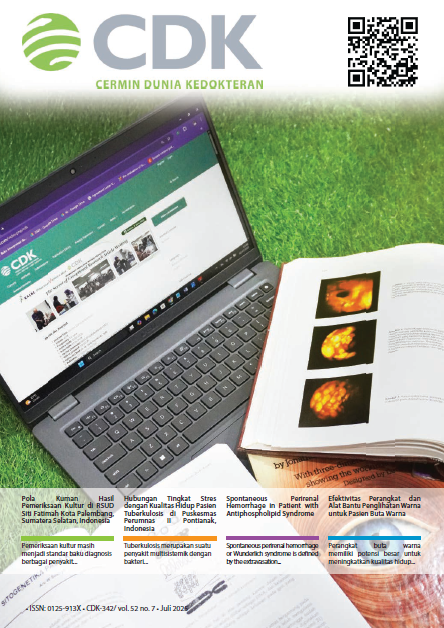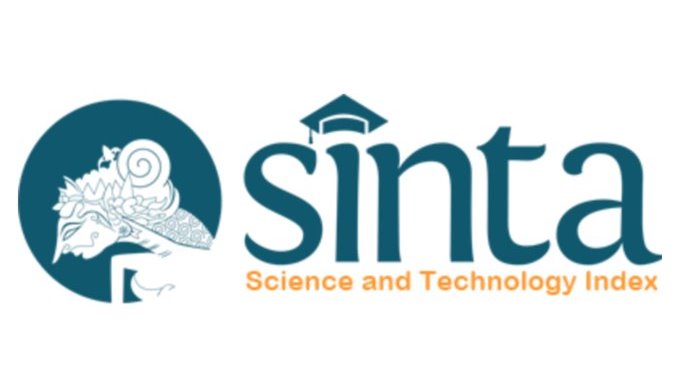Germ Pattern of Culture Examination Results at Siti Fatimah Hospital Palembang City, South Sumatra, Indonesia
Research
DOI:
https://doi.org/10.55175/cdk.v52i7.1350Keywords:
Bacteria, culture, germ patternAbstract
Introduction: Bacterial culture examination is the diagnostic standard for various infectious diseases. This descriptive research aims to determine the microorganism pattern in culture examinations at Siti Fatimah Regional Hospital, Palembang, South Sumatra, Indonesia. Methods: Secondary data were from records of microorganism culture examination results at the Clinical Pathology Laboratory of Siti Fatimah Regional Hospital, South Sumatra Province, from January to December 2022. Result: During that period, 217 samples were collected from various sources: 64 (29.5%) blood samples, 25 (11.5%) urine samples, 47 (21.7%) pus samples, 64 (29.5%) sputum samples, and 17 (7.8%) body fluid samples. Most samples’ characteristics were from patients who were >18-60 years old, male, and non-intensive inpatient ward patients. A total of 137 (63.1%) samples showed positive growth, mostly from sputum (60 samples; 93.8%), with the majority of bacteria being Klebsiella pneumoniae (11 samples; 18.3%). The most frequently detected bacteria in blood and urine cultures was Pseudomonas aeruginosa, in 5 samples (29.5%) and 3 samples (27.3%), respectively. Staphylococcus aureus was largely seen in pus (8 samples; 20%) and body fluid (3 samples; 33.3%) cultures. Conclusion: The results of the culture examination showed that most positive germ growth came from sputum, with the most bacteria found being Pseudomonas aeruginosa, Staphylococcus aureus, and Klebsiella pneumoniae.
Downloads
References
Limmathurotsakul D, Kris J, Arkhom A, Julia AS, Lisa JW, Sue JL, et al. Defining the true sensitivity of culture for the diagnosis of melioidosis using bayesian latent class Models. PLoS One 2010;5(8):e12485. DOI: 10.1371/journal.pone.0012485.
Bayot ML, Bragg BN. Antimicrobial susceptibility testing. StatPearls [Internet]. 2024 [cited 2024 Mar 3]. Available from: https://www.ncbi.nlm.nih.gov/books/NBK539714/. PMID: 30969536.
Lagier J, Edouard S, Pagnier I, Mediannikov O, Drancourt M, Raoult D. Current and past strategies for bacterial culture in clinical microbiology. Clin Microbiol. 2015;28(1):208-9. DOI: 10.1128/CMR.00110-14.
Boyles TH, Wasserman S. Diagnosis of bacterial infection. S Afr Med J. 2015;105(5):419.
Giuliano C, Patel CR, Kale-Pradhan PB. A guide to bacterial culture identification and results interpretation. P T. 2019;44(4):192-200. PMID: 30930604.
Chela HK, Vasudevan A, Rojas-Moreno C, Naqvi SH. Approach to positive blood cultures in the hospitalized patient: A review. Mol Med. 2019;116(4):313-7. PMID: 31527981.
Nannan Panday RS, Wang S, van de Ven PM, Hekker TAM, Alam N, Nanayakkara PWB. Evaluation of blood culture epidemiology and efficiency in a large European teaching hospital. PLoS One 2019;14(3):e0214052. DOI: 10.1371/journal.pone.0214052.
Sloane AJ, Pressel DM. Culture pus, not blood: Decreasing routine laboratory testing in patients with uncomplicated skin and soft tissue infections. Hosp Pediatr. 2016;6(7):394-8. DOI: 10.1542/hpeds.2015-0186.
Stevens DL, Alan LB, Henry FC, Patchen DW, Ellie JCG, Sherwood LG, et al. Practice guidelines for the diagnosis and management of skin and soft tissue infections: 2014 update by the Infectious Diseases Society of America. Clin Infect Dis. 2014;59(2):147-59. DOI: 10.1093/cid/ciu444.
Sinawe H, Casadesus D. Urine culture. StatPearls [Internet]. 2024 [cited 2024 Apr 14]. Available from: https://www.ncbi.nlm.nih.gov/books/NBK557569/. PMID: 32491501.
Shen F, Zubair M, Sergi C. Sputum analysis. StatPearls [Internet]. 2024 [cited 2024 Apr 14]. Available from: https://www.ncbi.nlm.nih.gov/books/NBK563195/. PMID: 33085342.
Kardana IM. Pola kuman dan sensitifitas antibiotik di ruang perinatologi. Sari Pediatri. 2011;12(6):381-5.
Ladyani F, Mutia Z. Analisis pola kuman dan pola resistensi pada pemeriksaan kultur resistensi di laboratorium patologi klinik rumah sakit Dr. H. Abdoel Moeloek provinsi Lampung periode Januari-Juli 2016. J Ilmu Kedokt Kes. 2018;5(2):77-88. DOI: https://doi.org/10.33024/.v5i2.789.
Nurmala N, Ign V, Andriani A, Delima FL. Resistensi dan sensitivitas bakteri terhadap antibiotik di RSU Dr. Soedarso Pontianak tahun 2011-2013. eJ Kedokt Indon. 2015;3(1):21-8. DOI: 10.23886/ejki.3.4803.
Wahyudhi A, Silvia T. Pola kuman dan uji kepekaan antibiotika pada pasien unit perawatan intensif anak RSMH Palembang. Sari Pediatri. 2010;12(1):1-5.
Caskurlu H, Davarci I, Kocoglu ME, Cag Y. Examination of blood and tracheal aspirate culture results in intensive care patients: 5-year analysis. Medeni Med J. 2020;35(2):128-35. DOI: 10.5222/MMJ.2020.89138.
Diggle SP, Whiteley M. Microbe profile: Pseudomonas aeruginosa: Opportunistic pathogen and lab rat. Microbiology (Reading). 2020;166(1):30-3. DOI: 10.1099/mic.0.000860.
Wu W, Jin Y, Bai F, Jin S. Pseudomonas aeruginosa. In: Tang YW, Dongyou L, Joseph S, Max S, Ian P, editors. Molecular medical microbiology. 2nd ed. New York: Academic Press; 2015. pp. 753-67.
Barung S, Sapan HB, Sumanti WM, Tubagus R. Pola kuman dari infeksi luka operasi pada pasien multitrauma. J Biomedik. 2017;9(2):115-20. DOI: 10.35790/jbm.9.2.2017.16360.
Haris S, Sarindah A, Yusni, Raihan. Kejadian infeksi saluran kemih di ruang rawat inap anak RSUD Dr. Zainal Abidin Banda Aceh. Sari Pediatri. 2012;14(4): 235-40.
Mittal R, Aggarwal S, Sharma S, Chhibber S, Harjai K. Urinary tract infections caused by Pseudomonas aeruginosa: A minireview. J Infection Publ Health. 2009;2(3): 101-11. DOI: 10. 1016/j.jiph.2009.08.003.
Chudlori B, Kuswandi M, Indrayudha P. Pola kuman dan resistensinya terhadap antibiotika dari spesimen pus di RSUD Dr. Moewardi tahun 2012. Pharmacon. 2012;13(2):70-6. DOI: 10.23917/pharmacon.v13i2.13.
Arianto DR, Romdhoni AC. Pola kuman, hasil uji sensitifitas antibiotik dan komplikasi abses leher dalam di RSUD Dr. Soetomo. J Ilmiah Kedokt Wijaya Kusuma. 2019;8(1):88-98. DOI: 10.30742/jikw.v8i1.557.
Bhunia AK. Foodborne microbial pathogens. Springer: New York; 2018. pp. 181-92.
Poorabbas B, Mardaneh J, Rezaei Z. Nosocomial infections: Multicenter surveillance of antimicrobial resistance profile of Staphylococcus aureus and gram negative rods isolated from blood and other sterile body fluids in Iran. Iran J Microbiol. 2015;7(3):127-35. PMID: 26668699.
Ravichitra KN, Prakash P, Subbarayudu S, Rao US. Isolation and antibiotic sensitivity of Klebsiella pneumoniae from pus, sputum and urine samples. Internat J Curr Microbiol Appl Sci. 2014;3(3):115-9.
Shilpa K, Thomas R, Ramyashree A. Isolation and antimicrobial sensitivity pattern of Klebsiella pneumoniae from sputum samples in a tertiary care hospital. Internat J Biomed Advance Res. 2016;7(2):53-7. DOI:10.7439/ijbar.v7i2.2945.
Khan R, Wali S, Pari B. Comprehensive analysis of Klebsiella pneumoniae culture identification and antibiogram: Implications for antimicrobial susceptibility patterns from sputum samples in Mardan, Khyber Pakhtunkhwa, Pakistan. Bacteria. 2023;2(4):155-73. DOI: 10.3390/bacteria2040012.
Downloads
Published
How to Cite
Issue
Section
License
Copyright (c) 2025 Dedi Yanto Husada, Ririn Eviningtyas

This work is licensed under a Creative Commons Attribution-NonCommercial 4.0 International License.





















